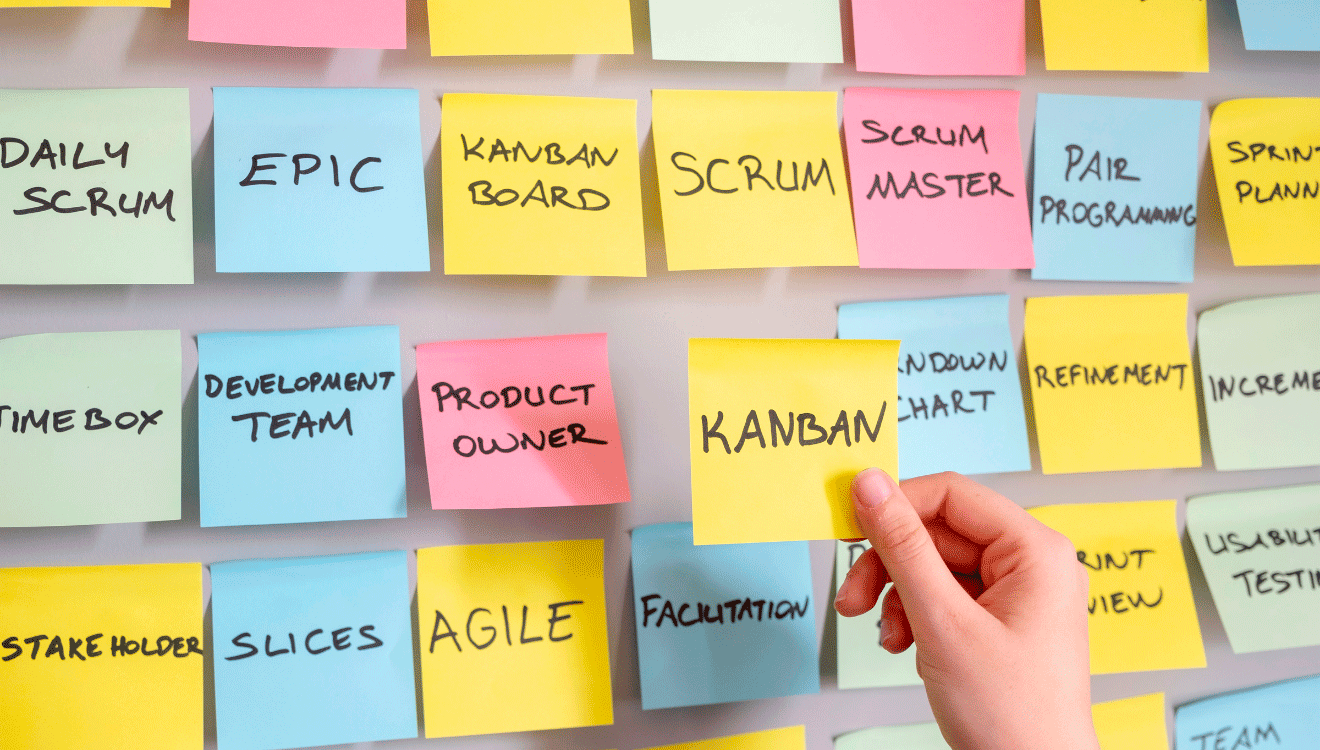Table of contents




Table of contents
What is Kanban? This is the question many entrepreneurs asked themselves right before achieving great success for their business. This Agile Management method has its origin in Japan and it works with visual (Kan) signalling (Ban) on a board that shows the existing workflow in a project. Like so, everybody can check its current status at a glance.
The Kanban technique technique allows the company to efficiently deal with the workflow, and that is why it’s becoming more and more popular among the business community. Its motto is “Stop starting, start finishing”, a mantra to improve efficiency and the capacity of prioritising tasks. The whole team will be involved in the process since they all will be able to know the real phase the project is in and to face any eventuality.
“Stop starting, start finishing” is the Kanban motto
You might be interested
You might be interested
Do you know the Scrum methodology?

Cristina Seriñá


You might be interested
You might be interested
What is Lean Management and why you should apply it to your company

David Vega


You might be interested
You might be interested
What is Benchmarking and how to do it in your company

Soraya Albaladejo


Of course, the Kanban methodology has a recipe to follow step by step if you want to make the most out of it. Here you’ll find some essentials you’ll have to keep in mind:
First of all, buy a board and place it somewhere accessible! This way, the team will be able to adapt to this new system asap. Do not forget to explain Kanban very carefully to everybody, highlighting its benefits. We know changes may be difficult sometimes, but they are for the best!
Remember, keep it simple! The Kanban board will only display three columns: “to-do”, “ongoing” and “done”.
According to the Kanban method, each task will go through the same three stages. Kanban encourages you to actually put them on paper to hang on the board and physically move the sticky notes when a task changes its state. Each note represents and element to work on.
Giving and receiving feedback from the team will always be helpful, so set up meetings from time to time so the project can move forward properly.
We are sure you think this is obvious, but don’t tell us you aren’t a bit workaholic! WIP limits are key to Kanban. Working on two different tasks at once means your mindset has to change every five minutes from one thing to another… and that is not efficient at all! WIP limits help to keep the work pace stable, avoiding multitasking. Focus on your thing and forget the rest for now!
Don’t forget to check out our latest article on work efficiency if you need some extra advice!
Although the Kanban method is applicable to companies of every kind, results won’t necessarily be the same. There are some productive processes this method is specially thought for. Here you’ll find some examples so you can weight up whether your company is among the best matches or not:
Whether you are a libra or not, making decisions like this must come after drawing a pros and cons list. Let’s make one for Kanban as well! Find here some benefits and disadvantages of this Kanban methodology.
PROS 👍🏻
CONS 👎🏻
One sec… what does Lean mean, then? We could say Lean Management is the second step after implementing Kanban. Its main goal is to optimise and speed-up mechanisms, erasing everything that won’t add value to the final product.
Thus, combining both Kanban and Lean will help your company losing what we call wastes, and improving the product’s quality. Once tasks are well organized and everything that doesn’t quite work is clear, it will be easier to identify and eliminate those wastes.
I you want to know a bit more about this Lean Methodology, click here to an article we found very interesting! Do not miss it!
Lean Management is the next step to take after implementing Kanban. Its main goal is to optimise and speed-up processes, erasing elements that just won’t add value to the final product.
Have you made up your mind yet? If you finally decide to bring Kanban on board, we hope it meets you and your team’s expectations. Best of luck!
“It's not enough to be busy; so are the ants. The question is: what are we busy about?”
Henry David Thoreau
Written by

Related articles
Get up to date with flex
Subscribe to our newsletter to make sure you don't miss anything. On trend content you’ll be interested in.
Contact us
Request information
Solicitar información free pass
Request a quote
Visit our spaces
Trabaja con nosotros
Contact us
Work in a flexible space.
Optimize on costs compared to a conventional office
Estimation of costs compared to conventional office hire
0 people Office for
Select
5 people
10 people
15 people
25 people
Select a number of people and we’ll show you the expenses included in our flexible office hire.
Conventional office
Operational costs and supply costs:
€/month
+ opening expenses
Flexible office
Operational costs and supply costs:
Included
No opening expenses
Included in the monthly bill
€517.01/person
0€
2.264,24 €/person
0€
523,69 €/person
0€
Guarantee bond
6 months
Deposit
2 months
Since
12 months
Since
1 month
2-6 months
2 months
Request a quote